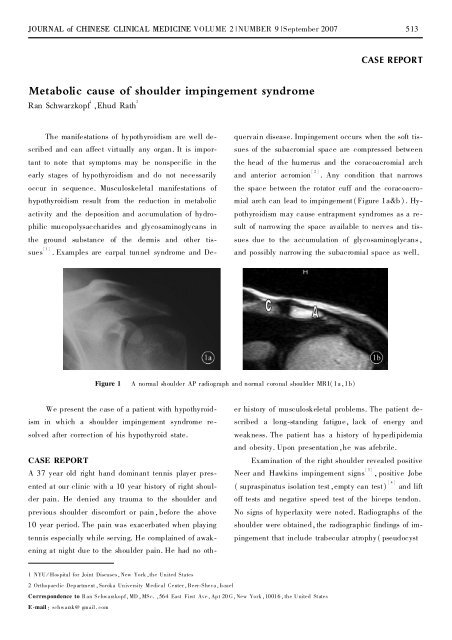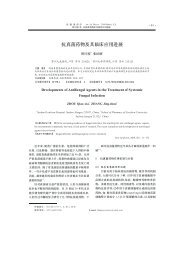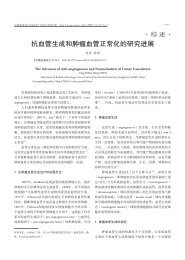Metabolic cause of shoulder impingement syndrome
Metabolic cause of shoulder impingement syndrome
Metabolic cause of shoulder impingement syndrome
Create successful ePaper yourself
Turn your PDF publications into a flip-book with our unique Google optimized e-Paper software.
JOURNAL <strong>of</strong> CHINESE CLINICAL MEDICINE VOLUME 2|NUMBER 9|September 2007<br />
<strong>Metabolic</strong> <strong>cause</strong> <strong>of</strong> <strong>shoulder</strong> <strong>impingement</strong> <strong>syndrome</strong><br />
Ran Schwarzkopf 1<br />
,Ehud Rath 2<br />
The manifestations <strong>of</strong> hypothyroidism are well de唱<br />
scribed and can affect virtually any organ.It is impor唱<br />
tant to note that symptoms may be nonspecific in the<br />
early stages <strong>of</strong> hypothyroidism and do not necessarily<br />
occur in sequence.Musculoskeletal manifestations <strong>of</strong><br />
hypothyroidism result from the reduction in metabolic<br />
activity and the deposition and accumulation <strong>of</strong> hydro唱<br />
philic mucopolysaccharides and glycosaminoglycans in<br />
the ground substance <strong>of</strong> the dermis and other tis唱<br />
.Examples are carpal tunnel <strong>syndrome</strong> and De唱<br />
sues [1]<br />
CASE REPORT<br />
quervain disease.Impingement occurs when the s<strong>of</strong>t tis唱<br />
sues <strong>of</strong> the subacromial space are compressed between<br />
the head <strong>of</strong> the humerus and the coracoacromial arch<br />
and anterior acromion [2]<br />
.Any condition that narrows<br />
the space between the rotator cuff and the coracoacro唱<br />
mial arch can lead to <strong>impingement</strong>(Figure 1a&b).Hy唱<br />
pothyroidism may <strong>cause</strong> entrapment <strong>syndrome</strong>s as a re唱<br />
sult <strong>of</strong> narrowing the space available to nerves and tis唱<br />
sues due to the accumulation <strong>of</strong> glycosaminoglycans,<br />
and possibly narrowing the subacromial space as well.<br />
Figure 1 A normal <strong>shoulder</strong> AP radiograph and normal coronal <strong>shoulder</strong> MRI(1a,1b)<br />
We present the case <strong>of</strong> a patient with hypothyroid唱<br />
ism in which a <strong>shoulder</strong> <strong>impingement</strong> <strong>syndrome</strong> re唱<br />
solved after correction <strong>of</strong> his hypothyroid state.<br />
CASE REPORT<br />
A 37 year old right hand dominant tennis player pres唱<br />
ented at our clinic with a 10 year history <strong>of</strong> right shoul唱<br />
der pain.He denied any trauma to the <strong>shoulder</strong> and<br />
previous <strong>shoulder</strong> discomfort or pain,before the above<br />
10 year period.The pain was exacerbated when playing<br />
tennis especially while serving.He complained <strong>of</strong> awak唱<br />
ening at night due to the <strong>shoulder</strong> pain.He had no oth唱<br />
1 NYU /Hospital for Joint Diseases,New York,the United States<br />
2 Orthopaedic Department,Soroka University Medical Center,Beer唱Sheva,Is rael<br />
Correspondence to Ran Schwarzkopf,MD,MSc.,564 East First Ave,Apt 20 G,New York,10016,the United States<br />
E 唱mail: schwarzk@ gmail .com<br />
513<br />
er history <strong>of</strong> musculoskeletal problems.The patient de唱<br />
scribed a long唱standing fatigue, lack <strong>of</strong> energy and<br />
weakness.The patient has a history <strong>of</strong> hyperlipidemia<br />
and obesity.Upon presentation,he was afebrile.<br />
Examination <strong>of</strong> the right <strong>shoulder</strong> revealed positive<br />
Neer and Hawkins <strong>impingement</strong> signs [3]<br />
, positive Jobe<br />
( supraspinatus isolation test,empty can test) [4]<br />
and lift<br />
<strong>of</strong>f tests and negative speed test <strong>of</strong> the biceps tendon.<br />
No signs <strong>of</strong> hyperlaxity were noted.Radiographs <strong>of</strong> the<br />
<strong>shoulder</strong> were obtained,the radiographic findings <strong>of</strong> im唱<br />
pingement that include trabecular atrophy( pseudocyst
514 JOURNAL <strong>of</strong> CHINESE CLINICAL MEDICINE VOLUME 2|NUMBER 9|September2007 formation) under the greater tuberosity <strong>of</strong> the humeral<br />
head and sclerosis <strong>of</strong> the undersurface <strong>of</strong> the acromion<br />
( Sourcil sign) and /or the cortex <strong>of</strong> the greater tuberos唱<br />
ity were not seen in this patient.Laboratory studies,<br />
which were done routinely,showed an elevated TSH <strong>of</strong><br />
160 U /ml, the rest <strong>of</strong> the studies were within normal<br />
ranges.The patient was managed with 100 mg <strong>of</strong> thy唱<br />
roxine per day during the week and 150 mg <strong>of</strong> thyrox唱<br />
ine during the weekend.The patient was not referred to<br />
physiotherapy.After one year <strong>of</strong> treatment, TSH levels<br />
returned to within normal range,the patient reported to唱<br />
tal alleviation <strong>of</strong> the <strong>shoulder</strong> pain and discomfort, ex唱<br />
amination revealed a negative Neer摧s and Hawkin摧s<br />
sign.During the treatment period,the patient reported<br />
occasional use <strong>of</strong> NSAIDS for pain relief.<br />
DISCUSSION<br />
In the last two decades,subacromial <strong>impingement</strong> syn唱<br />
drome has become an increasingly common diagnosis<br />
for patients who have a painful <strong>shoulder</strong>.Many <strong>cause</strong>s<br />
have been proposed for subacromial <strong>impingement</strong> syn唱<br />
drome.These factors can be broadly classified as intrin唱<br />
sic( intratendinous) or extrinsic ( extratendinous).To<br />
understand the etiology <strong>of</strong> subacromial <strong>impingement</strong>, it<br />
is important to understand the unique anatomical char唱<br />
acteristics <strong>of</strong> the subacromial space.Within this space,<br />
a number <strong>of</strong> s<strong>of</strong>t唱tissue structures are situated between<br />
two rigid structures.The superior border( the ro<strong>of</strong>) <strong>of</strong><br />
the space is the coracoacromial arch,which consists <strong>of</strong><br />
the acromion,the coracoacromial ligament,and the cor唱<br />
acoid process.The acromioclavicular joint is directly<br />
superior and posterior to the coracoacromial ligament.<br />
The inferior border( the floor) consists <strong>of</strong> the greater<br />
tuberosity <strong>of</strong> the humerus and the superior aspect <strong>of</strong> the<br />
humeral head.However, interposed between these two<br />
osseous structures are the rotator cuff tendons,the long<br />
head <strong>of</strong> the biceps tendon, the bursa, and the cora唱<br />
coacromial ligament.Normally,the bursa facilitates the<br />
motion <strong>of</strong> the rotator cuff beneath the arch.Any abnor唱<br />
mality that disturbs the relationship <strong>of</strong> these subacromi唱<br />
al structures may lead to <strong>impingement</strong>.<br />
Normal function <strong>of</strong> the thyroid gland is directed to<br />
the secretion <strong>of</strong> the active thyroid hormones that influ唱<br />
ence a diversity <strong>of</strong> metabolic processes.Hypothyroidism<br />
refers to a metabolic state resulting from a deficiency in<br />
thyroid hormone function, in which decreased caloric<br />
expenditure ( hypometabolism ) is a principal fea唱<br />
ture [1]<br />
.Hypothyroidism can result from any <strong>of</strong> a variety<br />
<strong>of</strong> abnormalities that leads to insufficient synthesis <strong>of</strong><br />
thyroid hormone.Theprevalenceis3% ~5% <strong>of</strong> the a唱<br />
dult population.Hypothyroidism usually arises from pri唱<br />
mary thyroid disease(95%),but in rare cases it is due<br />
to hypothalamic唱pituitary disease or generalized tissue<br />
resistance to thyroid hormone [1]<br />
.Hypothyroidism may<br />
manifest in different ways and can affect almost every<br />
organ system in the body.Hypothyroidism can first<br />
present with an assertion <strong>of</strong> different symptoms.These<br />
symptoms may include fatigue,myalgia,arthralgia,mus唱<br />
cle weakness, stiffness and cramps, dry skin, head唱<br />
aches, and menorrhagia.Brittle nails, thinning <strong>of</strong> hair,<br />
pallor,and symptoms <strong>of</strong> carpal tunnel <strong>syndrome</strong> may al唱<br />
so be seen [1]<br />
.<br />
Clinical connection between hypothyroidism and<br />
musculoskeletal manifestations is well documented in<br />
the literature [5]<br />
such as carpal tunnel <strong>syndrome</strong> and<br />
Dequervain disease.In clinical observations, we have<br />
had the impression that the prevalence <strong>of</strong> thyroid dys唱<br />
function in patients with <strong>shoulder</strong> <strong>impingement</strong> syn唱<br />
drome is higher than in the normal population.In a re唱<br />
view <strong>of</strong> the literature, we did not find a study that ex唱<br />
amined the association between rotator cuff impinge唱<br />
ment and hypothyroidism.One possible explanation for<br />
<strong>impingement</strong> <strong>syndrome</strong>,in hypothyroid patients,is infil唱<br />
tration <strong>of</strong> tendon sheaths with glycosaminoglycans; no<br />
studytodatehasevaluatedthishypothesis.<br />
The early recognition <strong>of</strong> hypothyroidism remains a<br />
challenge,especially when the decline in thyroid func唱<br />
tion is gradual.TSH levels in the blood remains the<br />
most reliable and accessible tool for diagnosing hypot唱<br />
hyroidism.<br />
In the case presented, <strong>impingement</strong> <strong>syndrome</strong><br />
presented in a patient without an overt presentation <strong>of</strong><br />
hypothyroidism, and after thyroid function was correc唱<br />
ted,the patient returned to playing tennis without any<br />
further discomfort or need for any adjuvant therapy.Al唱<br />
though the patient has reported intermittent use <strong>of</strong><br />
NSAIDS during the treatment period,the amount taken<br />
by the patient,for general pain relief has been well be唱
JOURNAL <strong>of</strong> CHINESE CLINICAL MEDICINE VOLUME 2|NUMBER 9|September 2007<br />
low therapeutic levels and in very lengthily intervals to<br />
be the primary reason for the improvement seen.But we<br />
can not discard a possible adjuvant contribution.<br />
In conclusion, we believe that further research is<br />
warranted to determine the prevalence <strong>of</strong> hypothyroid唱<br />
ism among patients with <strong>impingement</strong> <strong>syndrome</strong>.<br />
REFERENCES<br />
1畅Guha B,KrishnaswamyG,PeirisA.The diagnosis and management <strong>of</strong><br />
hypothyroidism.South Med J,2002 ,95 (5) :475 -480.<br />
515<br />
2畅Fongemie AE,Buss DD,Rolnick SJ.Management <strong>of</strong> <strong>shoulder</strong> impinge唱<br />
ment <strong>syndrome</strong> and rotator cuff tears.Am Fam Physician,1998,57<br />
(4):667 -674,680 -682.<br />
3畅Hawkins RJ, Kennedy JC.Impingement <strong>syndrome</strong> in athletes.Am J<br />
Sports Med,1980,8(3):151 -158.<br />
4畅Jobe FW,KvitneRS, Giangarra CE .Shoulder pain in the overhand or<br />
throwing athlete.The relationship <strong>of</strong> anteriorinstabilityand rotator cuff<br />
<strong>impingement</strong>.OrthopRev,1989 ,18 (9) :963 -975.<br />
5畅Cakir M, Samanci N, Balci N, Balci Mk.Musculoskeletal manifesta唱<br />
tions in patients with thyroid disease .Clin Endocrinol( Oxf),2003,59<br />
(2):162 -167.<br />
( Editor LEE)
















